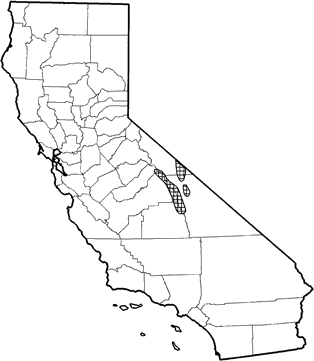
Uinta Chipmunk
Distribution, Abundance, and Seasonality
The Uinta chipmunk occurs at high elevations in the Inyo and White Mts., and in the southern Sierra Nevada from southern Mono Co. to northeastern Tulare Co. Optimal habitat is open, subalpine conifer forest of whitebark, foxtail, limber, and bristlecone pines. Prefers exposed slopes and ridges near timberline. In the White Mts., occurs from 2560-3450 m (8200-11,000 ft) (Hock 1963), and in the Sierra Nevada, from 2350-3280 m (7500-10,500 ft) (Johnson 1943).

Range Map
Specific Habitat Requirements
Feeding: Feeds mainly on seeds and fruits, including pines, juniper, grasses, and forbs, as well as on fungi. Searches on the ground, in shrubs, trees, and snags. Stores food in underground caches.
Cover: Uses scattered subalpine trees as refuges (Johnson 1943). Also uses brush and rocks for shelter.
Reproduction: Uses burrows, snags, and logs for nesting.
Water: Probably does not require water source other than food, but may use such sources if available.
Pattern: Associated with sparse to open-canopy subalpine conifer habitats.
Species Life History
Activity Patterns: Diurnal. Probably hibernates (Heller and Poulson 1970), with periods of dormancy lasting several days separated by arousals for feeding.
Seasonal Movements / Migration: None.
Home Range: In Nevada, home ranges measured 100 m (325 ft) in the longest dimension (Brown 1971).
Territory: May defend nest area and concentrated food sources. In Nevada, individuals were tolerant of conspecifics and frequently traveled in pairs or groups of mixed sex and age (Brown 1971).
Reproduction: On Wheeler Peak (Mono Co.), 2 females caught in mid-June had 4 and 5 embryos (Hall 1946); females were suckling young in early August at 10,500 ft. In the Toiyabe Mts. (7500-9000 ft), young were out of the burrow in June (Linsdale 1938).
Niche: This small, diurnal omnivore is sympatric with T. alpinus and T. speciosus at high elevations in the Sierra Nevada. Relationships with these species are unknown, but T. speciosus tends to occur in denser forests, and T. alpinus can occur where trees are absent. In the White Mts., T. umbrinus occurs at higher elevations than T. panamintinus, and at lower elevations than T. minimus. Predators probably include raptors, weasels, coyotes, foxes, and bobcats.
Comments: In California, this species has been studied very little, most research having been conducted in Nevada and Utah.
Sources & References
California Department of Fish and Game, 1999.
California's Wildlife, Sacramento, CA.
Written by: J. Harris, reviewed by: H. Shellhammer, edited by: R. Duke
Borell, A. E., and R. Ellis. 1934. Mammals of the Ruby Mountain region of northeastern Nevada. J. Mammal. 15:12-44 Brand, L. R. 1976. The Vocal Repertoire of Chipmunks (Genus Eutamias) in California. Anim. Behav. 24:319-335. Brown, J. H. 1971. Mechanisms of competitive exclusion between two species of chipmunks. Ecology 52:305-311. Hall, E. R. 1946. Mammals of Nevada. Univ. California Press, Berkeley. 710pp. Hall, E. R. 1981. The mammals of North America. Second ed. 2 Vols. John Wiley and Sons, New York. 1271pp. Heller, H. C., and T. L. Poulson. 1970. Circadian Rhythms-II. Endogenous and Exogenous Factors Controlling Reproduction and Hibernation in Chipmunks (Eutamias) and Ground Squirrels (Spermophilus). Comp. Biochem. Physiol. 33:357-383. Hock, R. J. 1963. Mammals of the White Mountain range, California. Univ. Calif. White Mt. Res. Sta. 5pp. Howell, A. B. 1924. The mammals of Mammoth, Mono County, California. J. Mammal. 5:25-36. Ingles, L. G. 1965. Mammals of the Pacific States. Stanford Univ. Press, Stanford, CA. 506pp. Johnson, D. H. 1943. Systematic Review of the Chipmunks (genus Eutamias) of California. Univ. Calif. Publ. Zool. 48:63-143. Linsdale, J. M. 1938. Environmental responses of vertebrates in the Great Basin. Am. Midl. Nat. 19:1-206. White, J. A. 1953. Taxonomy of the chipmunks, Eutamias quadrivittatus and Eutamias umbrinus. Univ. Kans. Mus. Nat. Hist. Publ. 5:563-582.
California Animal Facts | California's Wildlife